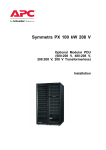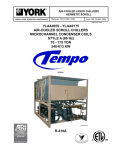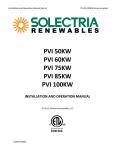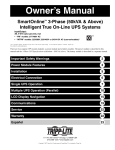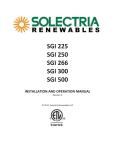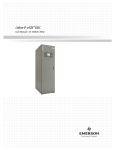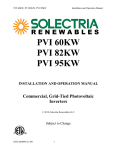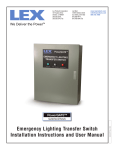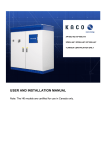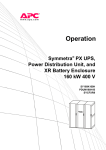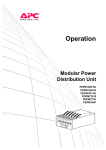Download APC 150 Power Supply User Manual
Transcript
Installation 150/175kW Modular PDU PDPM150G6F PDPM150L6F PDPM175G6H Contents Overview .......................................................................... 1 Important Safety Information . . . . . . . . . . . . . . . . . . . . . . . . . . . . . . . . 1 Disclaimer . . . . . . . . . . . . . . . . . . . . . . . . . . . . . . . . . . . . . . . . . . . . . . . 2 Please Note: . . . . . . . . . . . . . . . . . . . . . . . . . . . . . . . . . . . . . . . . . . . . 2 Additional Safety Information . . . . . . . . . . . . . . . . . . . . . . . . . . . . . . . 3 Before you begin . . . . . . . . . . . . . . . . . . . . . . . . . . . . . . . . . . . . . . . . 3 Operation and Adjustments . . . . . . . . . . . . . . . . . . . . . . . . . . . . . . . . 3 About This Manual .......................................................... 4 Related Documents. . . . . . . . . . . . . . . . . . . . . . . . . . . . . . . . . . . . . . . . 4 Product Related Information . . . . . . . . . . . . . . . . . . . . . . . . . . . . . . . . 4 User Comments. . . . . . . . . . . . . . . . . . . . . . . . . . . . . . . . . . . . . . . . . . . 4 Installation ....................................................................... 5 Electrical Safety . . . . . . . . . . . . . . . . . . . . . . . . . . . . . . . . . . . . . . . . . . 5 Inrow Installation. . . . . . . . . . . . . . . . . . . . . . . . . . . . . . . . . . . . . . . . . . 5 Perform Equipotential Bonding . . . . . . . . . . . . . . . . . . . . . . . . . . . . . . 6 Connect and Level Enclosures . . . . . . . . . . . . . . . . . . . . . . . . . . . . . . 6 Install Input Power Cables . . . . . . . . . . . . . . . . . . . . . . . . . . . . . . . . . . 7 Top entry installation . . . . . . . . . . . . . . . . . . . . . . . . . . . . . . . . . . . . . 7 Bottom entry installation . . . . . . . . . . . . . . . . . . . . . . . . . . . . . . . . . . 8 Install Subfeed Cables . . . . . . . . . . . . . . . . . . . . . . . . . . . . . . . . . . . . 10 Install User Input/Output Contacts . . . . . . . . . . . . . . . . . . . . . . . . . . 11 Install the Communication Cable . . . . . . . . . . . . . . . . . . . . . . . . . . . 13 150/175kW Modular PDU Installation i Power Distribution Modules (PDMs). . . . . . . . . . . . . . . . . . . . . . . . . 14 Installation . . . . . . . . . . . . . . . . . . . . . . . . . . . . . . . . . . . . . . . . . . . . . 14 Remove power distribution modules (PDMs) . . . . . . . . . . . . . . . . . 15 Install filler plates . . . . . . . . . . . . . . . . . . . . . . . . . . . . . . . . . . . . . . . 15 Options ........................................................................... 16 Shielding Troughs . . . . . . . . . . . . . . . . . . . . . . . . . . . . . . . . . . . . . . . 16 Seismic Stability Kit . . . . . . . . . . . . . . . . . . . . . . . . . . . . . . . . . . . . . . 17 Install rear anchoring brackets . . . . . . . . . . . . . . . . . . . . . . . . . . . . 17 Install front anchoring bracket . . . . . . . . . . . . . . . . . . . . . . . . . . . . . 18 Specifications ................................................................ 19 Recommended conductor sizes . . . . . . . . . . . . . . . . . . . . . . . . . . . 21 Regulatory Agency Approval ....................................... 22 ii 150/175kW Modular PDU Installation Overview Important Safety Information Read the instructions carefully and look at the equipment to become familiar with the device before trying to install, operate, service or maintain it. The following special messages may appear throughout this manual or on the equipment to warn of potential hazards or to call attention to information that clarifies or simplifies a procedure. The addition of this symbol to a Danger or Warning safety label indicates that an electrical hazard exists which will result in personal injury if the instructions are not followed. This is the safety alert symbol. It is used to alert you to potential personal injury hazards. Obey all safety messages that follow this symbol to avoid possible injury or death. DANGER DANGER indicates an imminently hazardous situation which, if not avoided, will result in death or serious injury. WARNING WARNING indicates a potentially hazardous situation which, if not avoided, can result in death or serious injury. CAUTION CAUTION indicates a potentially hazardous situation which, if not avoided, can result in minor or moderate injury. CAUTION CAUTION, used without the safety alert symbol, indicates a potentially hazardous situation which, if not avoided, can result in equipment damage. NOTICE NOTICE addresses practices not related to physical injury including certain environmental hazards, potential damage or loss of data. 150/175kw Modular PDU Installation 1 Disclaimer The information presented in this manual is not warranted by Schneider Electric to be authoritative, error free, or complete. This publication is not meant to be a substitute for a detailed operational and site specific development plan. Therefore, Schneider Electric assumes no liability for damages, violations of codes, improper installation, or any other problems that could arise based on the use of this publication. The information contained in this publication is provided as is and has been prepared solely for the purpose of evaluating data center design and construction. This publication has been compiled in good faith by Schneider Electric. However, no representation is made or warranty given, either express or implied, as to the completeness or accuracy of the information this publication contains. IN NO EVENT SHALL SCHNEIDER ELECTRIC, OR ANY AFFILIATE OR SUBSIDIARY COMPANY OF SCHNEIDER ELECTRIC OR THEIR RESPECTIVE OFFICERS, DIRECTORS, OR EMPLOYEES BE LIABLE FOR ANY DIRECT, INDIRECT, CONSEQUENTIAL, PUNITIVE, SPECIAL, OR INCIDENTAL DAMAGES (INCLUDING, WITHOUT LIMITATION, DAMAGES FOR LOSS OF BUSINESS, CONTRACT, REVENUE, DATA, INFORMATION, OR BUSINESS INTERRUPTION) RESULTING FROM, ARISING OUT OF, OR IN CONNECTION WITH THE USE OF, OR INABILITY TO USE THIS PUBLICATION OR THE CONTENT, EVEN IF SCHNEIDER ELECTRIC HAS BEEN EXPRESSLY ADVISED OF THE POSSIBILITY OF SUCH DAMAGES. SCHNEIDER ELECTRIC RESERVES THE RIGHT TO MAKE CHANGES OR UPDATES WITH RESPECT TO OR IN THE CONTENT OF THE PUBLICATION OR THE FORMAT THEREOF AT ANY TIME WITHOUT NOTICE. Copyright, intellectual, and all other proprietary rights in the content (including but not limited to software, audio, video, text, and photographs) rests with Schneider Electric or its licensors. All rights in the content not expressly granted herein are reserved. No rights of any kind are licensed or assigned or shall otherwise pass to persons accessing this information. This publication shall not be for resale in whole or in part. Please Note: Electrical equipment should be installed, operated, serviced, and maintained only by qualified personnel. No responsibility is assumed by Schneider Electric for any consequences arising from the use of this material. A qualified person is one who has skills and knowledge related to the construction, installation, and operation of electrical equipment and has received safety training to recognize and avoid the hazards involved. 2 150/175kw Modular PDU Installation Additional Safety Information Before you begin Verify that the system is free from all short circuits and grounds, except those grounds installed according to local regulations (according to the National Electrical Code in the U.S.A., for instance). If high-potential voltage testing is necessary, follow recommendations in equipment documentation to prevent accidental equipment damage. Before energizing equipment: • Remove tools, meters, and debris from equipment. • Close the equipment enclosure door. • Remove ground from incoming power lines. • Perform all start-up tests recommended by the manufacturer. Operation and Adjustments The following precautions are from the NEMA Standards Publication ICS 7.1-195 (English version prevails): • Regardless of the care exercised in the design and manufacture of equipment or in the selection and ratings of components, there are hazards that can be encountered if such equipment is improperly operated. • It is sometimes possible to misadjust the equipment and thus produce unsatisfactory or unsafe operation. Always use the manufacturer’s instructions as a guide for functional adjustments. Personnel who have access to these adjustments should be familiar with the equipment manufacturer's instructions and the machinery used with the electrical equipment. • Only those operational adjustments actually required by the operator should be accessible to the operator. Access to other controls should be restricted to prevent unauthorized changes in operating characteristics. WARNING UNGUARDED MACHINERY HAZARD • Do not use this product with equipment which does not have point-of-operation protection. • Do not reach into equipment during operation. Failure to follow these instructions can result in death, serious injury, or equipment damage. 150/175kw Modular PDU Installation 3 About This Manual This manual is intended for users of the specified APC equipment. It contains important safety warnings and instructions, gives an introduction to the display interface and provides detailed information for proper use of the equipment. Related Documents Download technical publications and other technical information or look for updates to your manual at our website at www.apc.com. Product Related Information DANGER HAZARD OF ELECTRIC SHOCK, EXPLOSION, OR ARC FLASH Turn off all power supplying this equipment before working on the equipment. Failure to follow these instructions will result in death or serious injury. User Comments We welcome your comments about this document. Contact www.apc.com/support. 4 150/175kw Modular PDU Installation Installation Electrical Safety SAVE THESE INSTRUCTIONS! This document contains important instructions that should be followed during installation of the 150/ 175kW Modular Power Distribution Unit (PDU). DANGER HAZARD OF ELECTRIC SHOCK • Only certified electricians are authorized to connect power to the PDU. • The PDU must be installed in accordance with the National Electrical Code or the Canadian Electrical Code and all applicable local codes. • To prevent arcing when removing a Power Distribution Module (PDM) from the panel, set all circuit breakers on that module to OFF (open). Failure to follow these instructions can result in death or serious injury. CAUTION UNPROTECTED OUTPUTS Remove cover plates from the unit before cutting holes for power cable access. Metal shavings can cause serious equipment damage. A metal punch can be used to make the holes in the plates. Failure to follow these instructions can result in injury or equipment damage. Inrow Installation Maintain 36” hot aisle spacing. pdx0849a Hot Aisle 150/175kw Modular PDU Installation 5 Proper bonding is essential to create an equipotential plane between service grounds and equipment during fault and transient conditions. Connect the two equipotential bonding conductors between adjacent enclosures in the system. The bonding conductors are pre-connected to the PDU. The M8 nuts and washers are supplied in the accessory kit. Move the equipotential bonding wires to fit your system configuration. pdx0850a Perform Equipotential Bonding Connect and Level Enclosures The equipment must be installed on a level floor. The leveling feet will stabilize the enclosure, but will not account for a badly sloped floor. If the PDU is on a raised-tile floor, verify that it is properly aligned with the tiles. 2. Use a screwdriver to lower the four leveling feet. 3. Use a 13/17 mm wrench to adjust the leveling feet. Do not move the enclosure after the leveling feet have been lowered. pdx0852a 1. Align the enclosures. pdx0851a 4. Turn the joining brackets and secure with a screw to connect the enclosures. 6 150/175kw Modular PDU Installation Install Input Power Cables Top entry installation 1 Open the front door. Unlatch and swing the display interface and bracket out towards the front door. 2 Loosen the captive screws and remove the top safety panel. 3 1 2 pdx0830a 3 Loosen the captive screws and remove the front top plate. 4 Remove the dedicated cover plate. Drill holes in the plate for conduits and re-install the plate with the conduits installed. 4 5 For PDPM150G6F and PDPM175G6H: L1, L2, L3 - Torque: 31.1 Nm (275 lb-in). Ground - Torque: 5.6 Nm (50 lb-in). 6 5 L2 L1 L3 pdx0847a 5 Connect the input power cables. For PDPM150L6F: L1, L2, L3 - Torque: 28.3 Nm (250 lb-in). Ground - Torque: 5.6 Nm (50 lb-in). Input Power 6 Grounding Electrode Conductor Torque: 62.2 Nm (550 lb-in). 150/175kw Modular PDU Installation 7 Bottom entry installation Note: The sidecar is required for undefloor wiring into the PDU. The Sidecar does not contain a switch or circuit breaker so a readily accessible disconnect device shall be incorporated external to the equipment. Sidecar Model PDPM150SC PDU Model PDPM150G6F PDPM150L6F PDPM175G6H PDPM100SC 1 Remove the dedicated cover plate. Drill holes in the plate for conduits and re-install the plate with the conduits installed. Route the conductors (input conductors in single utility systems or bypass conductors in dual utility systems) through the bottom of the Side Car. pdx0878a 2 Connect the input/bypass conductors to the L1, L2, L3, EGC, and GEC terminals and torque to specifications on label. 8 150/175kw Modular PDU Installation 3 Take the cables that are preinstalled in the Side Car and route them through the left side into the PDU. pdx0879a To PDU Power In 150/175kw Modular PDU Installation 9 Install Subfeed Cables 1 Open the rear doors. 1 2 pdx0823a 2 Remove the subfeed safety panel. 3 Loosen the four captive screws on each of two rear dedicated cover plates. Drill holes in the plates for conduits and re-install the plate with the conduits installed. 3 pdx0829a Note: Remove cover plates before cutting holes. 4 Connect the phase (L1, L2, L3) cables. Torque: 31.1 Nm (275 lb-in). 5 Connect the neutral (N) cable. Torque: 62.2 Nm (550 lb-in). G N 6 6 Connect the ground (G) cable. Torque: 5.6 Nm (50 lb-in). 4 7 Install the subfeed safety panel and close the rear doors of the PDU. Note: The same procedure is required to connect Subfeed 1 and Subfeed 2 Circuit Breakers. 10 5 L1 L2 L3 150/175kw Modular PDU Installation 4 G N L1 L2 L3 6 Install User Input/Output Contacts Note: Contact wires from external signaling, alarming, and sensing devices may be connected to the interface board to allow the controller to monitor these devices and to also control outside devices through the output contacts. 1 Open the front door and remove the top safety panel. 1 2 pdx0826a 2 Note the location of the interface board at the top of the PDU. 3 Loosen the captive screws and remove the plate. Remove the 3/4-in (64-mm) knockout. pdx0843a 3 4 Run the contact cables through the hole to the interface board. pdx0837a 4 150/175kw Modular PDU Installation 11 5 Make connections to the labelled terminals on the interface board. Note: Input Contacts are Normally open or Normally closed. Available Output Contacts: DPDT, 1A@30VDC AST0, AST1, AST2, ASTEN, AC/DC, +24V, and EPO CONTACT are reserved and not available. Wiring: 12 AWG to 30 AWG is recommended. 12 150/175kw Modular PDU Installation Install the Communication Cable 1 Connect the CAT-5 cable for StruxureWare Central or your local area network to the RJ45 connection coupling on top of the PDU. 1 3 The other end of the internal cable is plugged into the RJ-45 port on the panel cover of the controller located at the bottom of the unit. 150/175kw Modular PDU Installation pdx0837a 2 pdx0838a 2 Inside the PDU enclosure, a second CAT5 cable is connected to the other side of RJ45 coupling. Front 3 13 Power Distribution Modules (PDMs) Installation Note: 1. Power distribution modules can be safely installed when the PDU is operational. 2. Install only APC-supplied PDMs with matching output voltage. 3. Install PDMs starting from the bottom of the panel to avoid cable congestion. 1 Open the front door of the PDU. pdx0797a 1 2 Remove the filler plates. Press down on the filler plate clip to release its locking mechanism. Pull the filler plate directly toward you and along the slot on the left side of the panel until it is free. 2 3 Install a module. Make sure all breakers on the PDM being installed are in the OFF (open) position. OFF position 3 ON position 4 Press the red button to release the latch on the PDM. 5 Pull open the latch. 4 5 14 150/175kw Modular PDU Installation 6 Slide the PDM into the panel using the top and bottom guide tracks for that position. Make sure you slide the PDM all the way into its position. 7 Close the latch. This will tighten electrical contacts in the PDM against the busbar. 6 6 6 pdx0298b 8 Feed cable from the PDM through the slot in the roof of the PDU. Note: Leave a minimum of 7 inches (178 mm) of slack in the cable behind the module. The slack is useful in case the module is ever removed or replaced. 10 to 20 inches (254 to 508 mm) is recommended but space restrictions in the PDU and cable diameter size will cause the amount of slack to necessarily vary. Note: When installing PDMs near the top of the panel, perform step 8 before steps 6 and 7 to avoid cable congestion between the panel and the slot. 6 9 Set all breakers on the newly installed PDM to the ON (closed) position. Close the front door of the PDU. Connect the PDM cable to the appropriate rack-mount PDU or other equipment Remove power distribution modules (PDMs) Reverse the installation procedure to remove a PDM (making sure all breakers on the module are OFF). pdx0840a 7 pdx0839a 8 OFF position 9 ON position Install filler plates Install APC filler plates (part number 870-14628) to properly cover 3-pole panel positions that are not occupied by a power distribution module. j 150/175kw Modular PDU Installation 15 Options Shielding Troughs pdx0844a 1 1 Snap an APC-provided trough into slots on the roof of the PDU. The tabs at the base of the trough must fit securely into the slots. Note: Properly align the PDU trough with troughs installed on top of the enclosures located adjacent to the PDU. pdx0845a 2 2 Feed PDM cables through the roof of the PDU and into the trough system for connection with the appropriate rack-mount PDUs. 16 150/175kw Modular PDU Installation Seismic Stability Kit Install rear anchoring brackets 1 Secure the floor anchoring bracket to the floor using floor anchoring bolts (not supplied). Use M12 strength class 8.8 or 1/2 inch, grade 5 steel bolts. 1 2 Secure the back of the other half of the bracket assembly to the back of the unit. 2 3 Push the unit back to slide the bracket on the unit under the bracket bolted to the floor. 3 150/175kw Modular PDU Installation 17 Install front anchoring bracket 1 Secure the front anchoring bracket to the enclosure. 1 2 Secure the front anchoring bracket to the floor using floor anchoring bolts (not supplied). Use M12 strength class 8.8 or 1/2 inch, grade 5 steel bolts. 2 18 150/175kw Modular PDU Installation Specifications AC Input Model PDPM150G6F PDPM150L6F PDPM175G6H Nominal voltage 480V, 3W +G 600V, 3W +G 480V, 3W + G Frequency 60 Hz 60 Hz 60 Hz Maximum continuous current 180 A 150 A 214 A Nominal current 178 A 141 A 214 A Recommended current rating of input circuit breakers Mains Input1 (A) 225 200 300 2000 1500 2100 Inrush currents Inrush Current2 Standard circuit breakers are rated to carry 80% of their current rating continuously. 2 The supply overcurrent protective device must be able to handle the listed transformer inrush currents. 1 AC Output PDPM150G6F PDPM150L6F PDPM175G6H 208Y/120V, 3W + N + G 208Y/120V, 3W + N + G 415Y/240V, 3W + N + G 400 A 400 A 243 A 144 kW @ 208V 3 PH 144 kW @ 208V 3 PH 175kW @ 415V 3 PH 208/120V, 3-pole modules 208/120V, 3-pole modules 415/240V, 3-pole modules Power distribution poles available 72 72 72 Maximum number of PDMs 24 24 24 Model Nominal voltage Maximum continuous current Full load rating Power distribution module (PDM) 150/175kw Modular PDU Installation 19 Distribution Transformer PDPM150G6F PDPM150L6F PDPM175G6H Size 150 kVA 150 kVA 175 kVA Type Delta/Wye Delta/Wye Delta/Wye Input voltage 480V 600V 480V Input current 180 A 150 A 214 A Output voltage 208Y/120V 208Y/120V 415Y/240V Output current 399.72 A 399.72 A 243.47 180 NC 180 NC 180 NC 455 kg (1003 lb) 500 kg (1102 lb) 560 kg (1235 lb) Efficiency 98.2% min. 98.2% min. 98.5% min. Frequency 60 Hz 60 Hz 60 Hz < 55 db @ 1 m < 55 db @ 1 m < 55 db @ 1 m Model Thermal sensing Weight Noise Environment and Compliance Temperature Operating: -5 to +40°C (23 to 104°F) Storage: -25 to +65°C (-13 to 149°F) Humidity Operating: 0 to 95%, non-condensing Storage: 0 to 95%, non-condensing Elevation 3000 m (9,842.5 ft) Certification UL and cUL Conditional Short-Circuit Current Rating (ICC) 10 kA* * The Conditional Short-Circuit Current Rating was not evaluated by Underwriters Laboratories. Note: Circuit breakers and conductor ampacity are derated in accordance with the National Electrical Code. 20 150/175kw Modular PDU Installation Recommended conductor sizes Note: All wiring must comply with all applicable national and or local electrical codes. Conductor sizing in this manual is based on Table 310-16 of the 2011 National Electrical Code (NEC) with the following assertions: • 90°C conductors (THHN) for 75°C termination • 3 Current Carrying Conductors for Unit Input Circuit Breaker and 4 Current Carrying Conductors for Subfeed Circuit Breaker • An ambient temperature of 30°C • Two conduits for each subfeed • One Equipment Grounding Conductor for each conduit If the ambient room temperature is greater than 30°C, larger conductors are to be selected in accordance with the correction factors of the NEC. Equipment Grounding Conductors (EGC) are sized in accordance with NEC Article 250-122 and Table 250-122. Grounding Electrode Conductors (GEC) are sized in accordance with NEC Article 250-66 and Table 250-66. The conductor sizes are recommendations for maximum configurations. Even if the load is less than the maximum rating, it is wise to plan for future load increases. If the system is operated at a lower load than its rating and it is desired to supply the system with a lower rated breaker and smaller conductors, conductor ampacities are to be selected in accordance with the NEC. The transformer inrush must be taken into account when sizing conductors. Table for 40°C ambient/4CCC PDPM150G6F 480:208 PDPM150L6F 600:208 PDPM175G6H 480:415 Cu only: 250kcmil 75°C conductor minimum Cu only: 3/0 AWG 90°C conductor minimum Cu: 350kcmil Al: 500kcmil 75°C conductor minimum Equipment Grounding Conductor (EGC) Cu: 4 AWG Cu: 6 AWG Cu: 4 AWG Al: 2 AWG Grounding Electrode Conductor (GEC) Cu: 2 AWG Cu: 2 AWG Cu: 2 AWG Al: 1/0 AWG Mains Input Φ Output Subfeed Output Supplied with Power Distribution Modules Cu only: (2) 300kcmil Φ and Cu only: (2) 300kcmil Φ and Cu: (2) 2/0 AWG Φ and N, 4 N, 3 AWG EGC, GEC not N, 3 AWG EGC, GEC not AWG EGC, GEC not required. required. required. 90°C conductor minimum 90°C conductor minimum Al: (2) 4/0 AWG Φ and N, 2 AWG EGC, GEC not required. 75°C conductor minimum 150/175kw Modular PDU Installation 21 Table for 30°C ambient/4CCC PDPM150G6F 480:208 PDPM150L6F 600:208 PDPM175G6H 480:415 Mains Input Φ Cu: 4/0 AWG A1: 300kcmil 75°C conductor minimum Cu only: 3/0 AWG 90°C conductor minimum Cu: 300kcmil Al: 400kcmil 75°C conductor minimum Equipment Grounding Conductor (EGC) Cu: 4 AWG A1: 2 AWG Cu: 6 AWG Cu: 4 AWG Al: 2 AWG Grounding Electrode Conductor (GEC) Cu: 2 AWG A1: 1/0 AWG Cu: 2 AWG Cu: 2 AWG Al: 1/0 AWG Output Supplied with Power Distribution Modules Subfeed Output Cu: (2) 250kcmil Φ and N, Cu: (2) 250kcmil Φ and N, Cu: (2) 2/0 AWG Φ and N, 3 AWG EGC, GEC not 3 AWG EGC, GEC not 4 AWG EGC, GEC not required. required. required. Al: (2) 350 kcmil Φ and N, Al: (2) 350 kcmil Φ and N, Al: (2) 3/0 AWG Φ and N, 1 AWG EGC, GEC not 1 AWG EGC, GEC not 2 AWG EGC, GEC not required. required. required. 90°C conductor minimum 90°C conductor minimum 75°C conductor minimum Φ = phase, N = neutral (2) = two conductors per phase and neutral (when neutral is required) Subfeed is required to have two conductors per phase & N for full output due to limited wire bend space Cu= Copper conductors, Al= Aluminum conductors CCC = Current Carrying Conductor Regulatory Agency Approval This equipment has been tested and found to comply with the limits for a Class A digital device, pursuant to Part 15 of the FCC and ICES-003 Rules. These limits are designed to provide reasonable protection against harmful interference when the equipment is operated in a commercial environment. This equipment generates, uses, and can radiate radio frequency energy and, if not installed and used in accordance with the Installation Guide, may cause harmful interference to radio communications. Operation of this equipment in a residential area is likely to cause harmful interference, in which case the user will be required to correct the interference at his own expense. 22 150/175kw Modular PDU Installation Radio Frequency Interference Note: Changes or modifications to this unit not expressly approved by the party responsible for compliance could void the user’s authority to operate this equipment. USA—FCC This equipment has been tested and found to comply with the limits for a Class A digital device, pursuant to part 15 of the FCC Rules. These limits are designed to provide reasonable protection against harmful interference when the equipment is operated in a commercial environment. This equipment generates, uses, and can radiate radio frequency energy and, if not installed and used in accordance with this user manual, may cause harmful interference to radio communications. Operation of this equipment in a residential area is likely to cause harmful interference. The user will bear sole responsibility for correcting such interference. Canada—ICES This Class A digital apparatus complies with Canadian ICES-003. Cet appareil numérique de la classe A est conforme à la norme NMB-003 du Canada. APC Worldwide Customer Support Customer support for this or any other APC product is available at no charge in any of the following ways: • Visit the APC Web site to access documents in the APC Knowledge Base and to submit customer support requests. – www.apc.com (Corporate Headquarters) Connect to localized APC Web sites for specific countries, each of which provides customer support information. – www.apc.com/support/ Global support searching APC Knowledge Base and using e-support. • Contact the APC Customer Support Center by telephone or e-mail. – Local, country-specific centers: go to www.apc.com/support/contact for contact information. For information on how to obtain local customer support, contact the APC representative or other distributors from whom you purchased your APC product. © 2012 APC by Schneider Electric. APC, and the APC logo are owned by Schneider Electric Industries S.A.S., American Power Conversion Corporation, or their affiliated companies. All other trademarks are property of their respective owners. 990-4384 5/2012




























